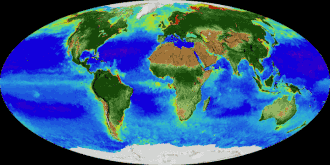Desert






Desert is a large, dry, and often sandy region of land that receives very little rainfall. Deserts can be found all over the world, and they are characterized by their harsh conditions and lack of vegetation. Despite these conditions, deserts are home to a variety of plant and animal species that have adapted to survive in such an environment.
Characteristics[edit]
Deserts are defined by their lack of precipitation. They receive less than 250 millimeters of rain per year, which is significantly less than most other types of ecosystems. This lack of water makes deserts some of the harshest environments on Earth. The soil in deserts is often sandy or rocky, and there is little organic material to support plant life.
Types of Deserts[edit]
There are four main types of deserts: hot and dry deserts, semiarid deserts, coastal deserts, and cold deserts. Each of these types of deserts has its own unique characteristics and species of plants and animals.
Flora and Fauna[edit]
Despite the harsh conditions, many species of plants and animals have adapted to live in deserts. These species have developed unique adaptations to survive in the extreme conditions of the desert. For example, many desert plants have thick, waxy leaves to prevent water loss, and many desert animals are nocturnal to avoid the heat of the day.
Human Interaction[edit]
Humans have lived in and around deserts for thousands of years. Many ancient civilizations, such as the Egyptians and the Romans, were located near deserts and used them for trade and transportation. Today, many people still live in desert regions, and they have developed ways to survive and thrive in these harsh environments.
Gallery[edit]
-
Desert
-
Desert
-
Desert
-
Desert
-
Desert
-
Desert
See Also[edit]
Ad. Transform your life with W8MD's Budget GLP-1 injections from $75


W8MD offers a medical weight loss program to lose weight in Philadelphia. Our physician-supervised medical weight loss provides:
- Weight loss injections in NYC (generic and brand names):
- Zepbound / Mounjaro, Wegovy / Ozempic, Saxenda
- Most insurances accepted or discounted self-pay rates. We will obtain insurance prior authorizations if needed.
- Generic GLP1 weight loss injections from $75 for the starting dose.
- Also offer prescription weight loss medications including Phentermine, Qsymia, Diethylpropion, Contrave etc.
NYC weight loss doctor appointmentsNYC weight loss doctor appointments
Start your NYC weight loss journey today at our NYC medical weight loss and Philadelphia medical weight loss clinics.
- Call 718-946-5500 to lose weight in NYC or for medical weight loss in Philadelphia 215-676-2334.
- Tags:NYC medical weight loss, Philadelphia lose weight Zepbound NYC, Budget GLP1 weight loss injections, Wegovy Philadelphia, Wegovy NYC, Philadelphia medical weight loss, Brookly weight loss and Wegovy NYC
|
WikiMD's Wellness Encyclopedia |
| Let Food Be Thy Medicine Medicine Thy Food - Hippocrates |
Medical Disclaimer: WikiMD is not a substitute for professional medical advice. The information on WikiMD is provided as an information resource only, may be incorrect, outdated or misleading, and is not to be used or relied on for any diagnostic or treatment purposes. Please consult your health care provider before making any healthcare decisions or for guidance about a specific medical condition. WikiMD expressly disclaims responsibility, and shall have no liability, for any damages, loss, injury, or liability whatsoever suffered as a result of your reliance on the information contained in this site. By visiting this site you agree to the foregoing terms and conditions, which may from time to time be changed or supplemented by WikiMD. If you do not agree to the foregoing terms and conditions, you should not enter or use this site. See full disclaimer.
Credits:Most images are courtesy of Wikimedia commons, and templates, categories Wikipedia, licensed under CC BY SA or similar.
Translate this page: - East Asian
中文,
日本,
한국어,
South Asian
हिन्दी,
தமிழ்,
తెలుగు,
Urdu,
ಕನ್ನಡ,
Southeast Asian
Indonesian,
Vietnamese,
Thai,
မြန်မာဘာသာ,
বাংলা
European
español,
Deutsch,
français,
Greek,
português do Brasil,
polski,
română,
русский,
Nederlands,
norsk,
svenska,
suomi,
Italian
Middle Eastern & African
عربى,
Turkish,
Persian,
Hebrew,
Afrikaans,
isiZulu,
Kiswahili,
Other
Bulgarian,
Hungarian,
Czech,
Swedish,
മലയാളം,
मराठी,
ਪੰਜਾਬੀ,
ગુજરાતી,
Portuguese,
Ukrainian






